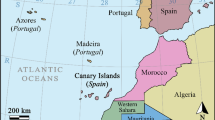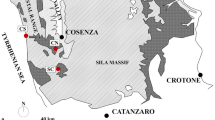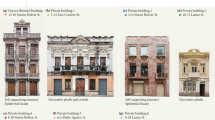Abstract
This work defines the physical and mechanical characteristics of phyllites and metagreywackes belonging to a schist–greywacke complex in central Portugal. The index properties, point load strength, uniaxial compressive strength, slake durability and Schmidt rebound hardness were determined. In general, the metagreywackes gave a higher strength than phyllites with the same weathering degree. Possible correlations and estimation models were established and compared with the equations obtained by different researchers.
Résumé
Cet article présente les caractéristiques physiques et mécaniques des phyllites et métagrauwackes appartenant au “Complexe Schiste–Grauwacke” situé dans le centre du Portugal. Les indices géotechniques, l’indice de résistance entre pointes, la résistance à la compression simple, la durabilité et la dureté de rebond Schmidt ont été déterminés. En général, les métagrauwackes présentent une plus grande résistance que les phyllites ayant le même degré d’altération. Des corrélations possibles et des modèles d’estimation ont été développés et comparés aux équations obtenues par des différents chercheurs.









Similar content being viewed by others
References
Andrade PS, Saraiva AA (2008) Estimating the joint roughness coefficient of discontinuities found in metamorphic rocks. Bull Eng Geol Environ 67:425–434
ASTM (1992) Standard test methods for absorption and bulk specific gravity of natural building stone. Annual book of ASTM Standards, vol 04.08, C 97–90:1–2
Aydin A, Basu A (2005) The Schmidt hammer in rock material characterization. Eng Geol 81:1–14
Beavis FC, Roberts I, Minskaya L (1982) Engineering aspects of weathering of low grade metapelites in an arid climatic zone. Q J Eng Geol 15:29–45
Bieniawski ZT (1974) Geomechanics classification of rock masses and its application to tunnelling. In: Proceedings of the 3rd international congress of the society rock mechanics, vol II-A. Denver, pp 109–114
Bieniawski ZT (1975) The point-load test in geotechnical practice. Eng Geol 9:1–11
Bieniawski ZT (1989) Engineering rock mass classification. Wiley, Chichester
Broch E, Franklin JA (1972) The point load strength test. Int J Rock Mech Min Sci 9:669–697
Buyuksagis IS, Goktan RM (2007) The effect of Schmidt hammer type on uniaxial compressive strength prediction of rock. Int J Rock Mech Min Sci 44:299–307
CEN (1997) Methods of test for natural stone units—determination of real density and apparent density, and of total and open porosity. Comité Européen de Normalisation, Brussels
Deere DU (1964) Technical description of cores for engineering purposes. Rock Mech Eng Geol 1:17–22
Entwisle DC, Hobbs PRN, Jones LD, Gunn D, Raines MG (2005) The relationships between effective porosity, uniaxial compressive strength and sonic velocity of intact Borrowdale volcanic group core samples from Sellafield. Geotech Geol Eng 23:793–809
Forster IR (1983) The influence of core sample geometry on the axial point load test. Int J Rock Mech Min Sci 20:291–295
Gamble JC (1971) Durability-plasticity classification of shales and other argillaceous rocks. PhD thesis, University of Illinois, Urbana
Ghosh DK, Srivastava M (1991) Point-load strength: an index for classification of rock material. Bull Eng Geol Environ 44:27–33
Goodman R (1989) Introduction to rock mechanics. Wiley, New York
Guyader J, Denis A (1986) Propagation des ondes dans les roches anisotropes sous contrainte. Évaluation de la qualité des schistes ardoisiers. Bull Eng Geol Environ 33:49–55
Hamrol A (1961) A quantitative classification of the weathering and weatherability of rocks. In: Proceedings of the 5th international conference of soil mechanics and foundation engineering, vol 2. Paris, pp 771–774
Hawkins AB (1998) Aspects of rock strength. Bull Eng Geol Environ 57:17–30
IAEG (1979) Classification of rocks and soils for engineering geological mapping. Part I—rock and soil materials. Bull Eng Geol Environ 19:364–371
ISRM (1981) Rock characterisation testing and monitoring. In: Brown ET (ed) Pergamon press, Oxford
ISRM (1985) Suggested method for determining point-load strength. Int J Rock Mech Min Sci 22:51–60
Jenni JP, Balissat M (1979) Rock testing methods performed to predict the utilisation possibilities of a tunnel boring machine. In: Proceedings of 4th congress international of the society rock mechanics, Montreaux, pp 267–273
Kahraman S (2001) Evaluation of simple methods for assessing the uniaxial strength of rock. Int J Rock Mech Min Sci 38:981–994
Kahraman S, Gunaydin O, Fener M (2005) The effect of porosity on the relation between uniaxial compressive strength and point load index. Int J Rock Mech Min Sci 42:584–589
Kiliç A, Teymen A (2008) Determination of mechanical properties of rocks using simple methods. Bull Eng Geol Environ 67:237–244
Kossev NV (1970) Corrélations entre les caractéristiques physiques et mécaniques de certaines roches, ayant égard au degré de l’altération des roches. In: Proceedings of the 2nd congress international society rock mechanics, vol 1. Belgrade, pp 29–35
Sabatakakis N, Koukis G, Tsiambaos G, Papanakli S (2008) Index properties and strength variation controlled by microstructure for sedimentary rocks. Eng Geol 97:80–90
Serviços Geológicos de Portugal (SGP) (1992) Carta geológica de Portugal—escala 1:500 000. Lisboa, Portugal
Sharma PK, Singh TN (2008) A correlation between P-wave velocity, impact strength index, slake durability index and uniaxial compressive strength. Bull Eng Geol Environ 67:17–22
Smith HJ (1997) The point load test for weak rock in dredging applications. Int J Rock Mech Min Sci 34:295.e1–295.e13
Song I, Suh M, Woo Y-K, Hao T (2004) Determination of the elastic modulus set of foliated rocks from ultrasonic velocity measurements. Eng Geol 72:293
Tugrul A, Zarif IH (1999) Correlation of mineralogical and textural characteristics with engineering properties of selected granitic rocks from Turkey. Eng Geol 51:303–317
Wiesner E, Gillate SJ (1997) An evaluation of the relation between unconfined compressive strength and point load strength index. Bull Eng Geol Environ 56:115–118
Xu S, Grasso P, Mahtab A (1990) Use of Schmidt hammer for estimating mechanical properties of weak rock. In: Proceedings of 6th international IAEG congress, Amsterdam, Balkema, Rotterdam, vol 1, pp 511–519
Yaşar E, Erdoğan Y (2004) Estimation of rock physicomechanical properties using hardness methods. Eng Geol 71:281–288
Acknowledgments
The financial support provided by Fundação para a Ciência e a Tecnologia and by Centro de Geociências of the University of Coimbra was essential for the execution of this study.
Author information
Authors and Affiliations
Corresponding author
Rights and permissions
About this article
Cite this article
Andrade, P.S., Saraiva, A.A. Physical and mechanical characterization of phyllites and metagreywackes in central Portugal. Bull Eng Geol Environ 69, 207–214 (2010). https://doi.org/10.1007/s10064-009-0251-9
Received:
Accepted:
Published:
Issue Date:
DOI: https://doi.org/10.1007/s10064-009-0251-9




